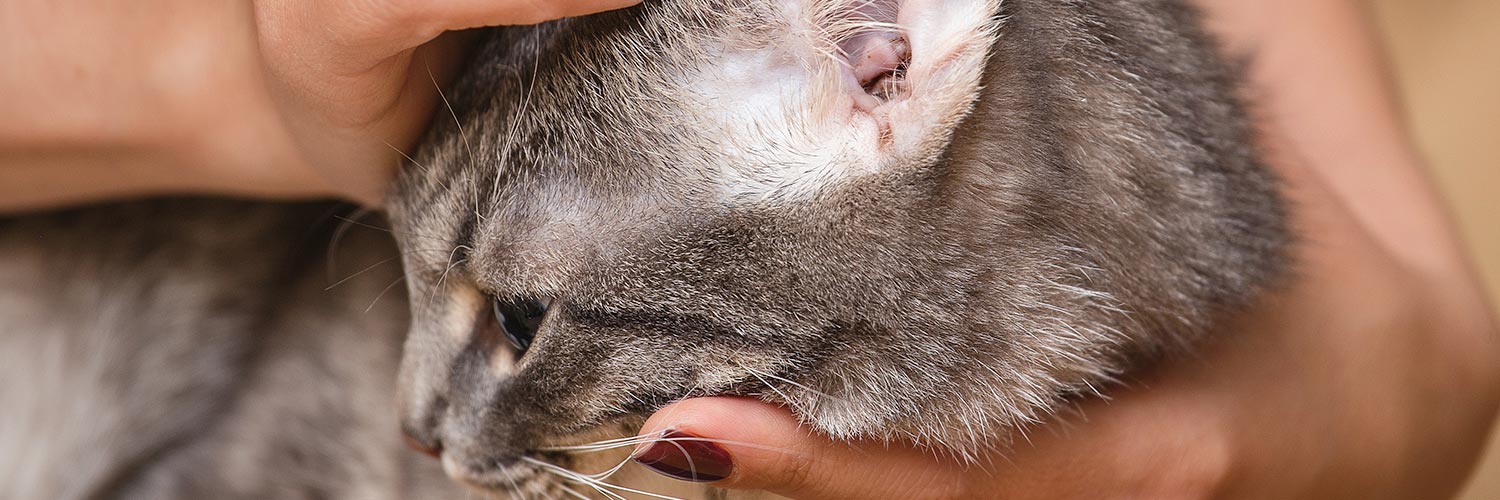How Do Cats Get Ear Mites?
Contents of Article
Ear mites can affect virtually any animal, but are extremely common in cats. Knowing about ear mites, what the symptoms are and how to treat them is incredibly important for any feline owner.
What exactly are ear mites? They’re tiny, highly contagious parasites that live in the internal and external canals of your cat’s ears. There are different kinds of ear mites but the most common one is otodectes cynotis, which is a small, white eight-legged insect. These mites feed off the skin and oils inside the cat’s ears, leaving behind a dark coffee ground like debris.
These pesky insects can be difficult to eradicate due to a long life cycle and easily spread to other animals in close proximity. With how much trouble they cause, how do cats get ear mites in the first place?
Quick Answer …
Ear mites spread so easily, your cat can get them from casual contact with another infected pet either inside or outside your house. It’s pretty common that outdoor cats suffer from ear mites, but it’s also easy for an indoor cat to be infected, too.
How Do Cats Get Ear Mites?
While it’s pretty easy for a cat to contract ear mites they can be a little challenging to get rid of, especially if you have any other pets — they’re likely infected as well.
Before making the call your cat has ear mites, look for these common symptoms.
Symptoms of Ear Mites
When we took in my youngest cat from outside, he wouldn’t stop scratching his ears or shaking his head like there was something in his ears. Little did I know, he had a pretty bad ear mite infestation! They’re more common in kittens, especially outside ones.
The most common symptom of ear mites are cats scratching their ears a and shaking their head a lot. You’ll also notice a dark brown discharge building up in the cat’s ear that resembles coffee grounds. This is a mixture of blood, wax and other debris from the ear mite infestation. You might also notice an odor coming from the ears, or inflammation around the ears.
While these symptoms signify ear mites, it’s important to get a proper diagnosis from the vet since cats can get all kinds of ear infections.
Ear Mite Treatment
Before administering any treatment, it’s important to visit a veterinarian. They can properly diagnose your cat. They’ll take a sample of your cat’s ear wax and look at it under a microscope to confirm the presence of ear mites. This is important because you cat could also be suffering from a different kind of ear infection, and you need to be sure ear mites are the issue at hand.
Ear mite treatment requires special ear drops over the course of a few days, depending on the severity of the infestation. Prior to medicating your cat with the ear drops, you’ll have to clean any debris from the ears. If you don’t clean out the debris first, the ear mites could be shielding themselves with it, and the medication won’t get to them.
When cleaning out your cat’s ears, use a cotton ball and not a q-tip! Cats tend to jerk their heads around a lot, especially when you’re putting something inside their ears. A q-tip could easily damage their ear canal or even puncture the eardrum if they were to move the wrong way.
Once all the debris and ear wax is out of the way, it’s time to administer the medicated drops. You might need two people for this job, as some cats really don’t want to stay still for this part. Administer the drops according to the instructions given by your vet, or on the medicine’s label.
The medicine should work pretty quickly, and you’ll see results within a few days. You will still have to be vigilant for a recurring infection, as the ear mite life cycle is three weeks long.
These drops should successfully get rid of any ear mites your cat had, but there are still more steps to take to prevent it from happening again.
Ear Mite Prevention
There are a few things you can do to prevent another ear mite infestation in your cat. A monthly topical application of Revolution can prevent ear mites, as well as other parasites like fleas and worms, from infecting your cat.
Once all pets in your home have been treated against any prior ear mite infestation, make sure to wash all their bedding and clean any carpets. Eat mites have a three week life cycle, so they can continue to live on other items and infest your animals again a few weeks from now.
After everything’s been thoroughly cleaned and treated, keep your indoor pets from coming into contact with outside animals as best you can.
Can Humans Get Ear Mites from Cats?
While it technically is possible for a human to get ear mites from a cat, it’s very hard to do so. You’d have to literally infect your own ears with the ear mites from your cat — it won’t just happen from you living with your infected cat. Also, humans aren’t the preferred host for ear mites as they prefer the depth and ear canals of your furry friend instead.
There’s really no need to worry about becoming infected with ear mites from your cat.
Your Cat’s Ears are Important!
Untreated ear mites can lead to serious issues, as the debris can end up completely blocking the ear canal. This leads to infection, loss of hearing and increased pain and suffering for your cat.
A cat’s ears are just another incredible feline feature — organs housed deep in your cat’s inner ear canal are responsible for their amazing balance. It’s a mixture of sensitive hairs, fluids and crystals that send signals to the cat’s brain about body positions.
Based on how important their ear canals are, you can probably see why even a small infestation of mites can throw off their sense of balance and cause even more serious issues and discomfort if left untreated.







